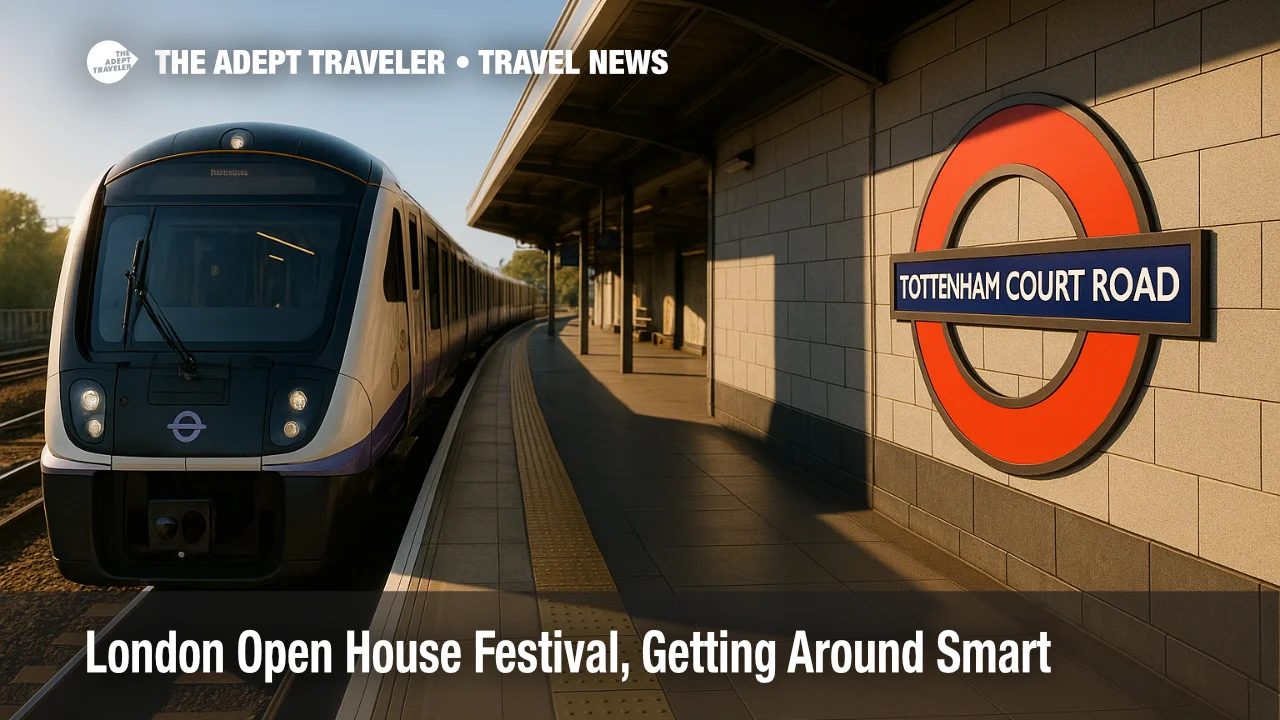London Open House Festival, getting around smart

The London Open House Festival runs September 13 to 21, opening hundreds of buildings and community spaces across the capital. Expect concentrated foot traffic at icons, neighborhood landmarks, and popular residential streets. The smartest plan is to ride the Elizabeth line for fast cross-city moves, use buses for last-mile hops, and walk when possible. Avoid arranging car hires or taxi pick-ups near Shoreditch, Clerkenwell, and Westminster at peak times, where queues and short-term closures can snarl roads.
Key Points
- Why it matters: Open House spreads crowds across central and inner neighborhoods, slowing surface travel.
- Travel impact: Elizabeth line works best for long hops, buses and walking for last mile.
- What's next: Tube strikes are scheduled to end September 11, before the festival opens. Recheck status in case plans change.
- Many venues require pre-booking and timed entry, so secure slots in advance.
- Accessibility options include audio-described tours on select programs.
Snapshot
Open House is produced by the charity Open City, with a 2025 lineup spanning more than 800 free open days and events across 33 boroughs. Highlights range from government and civic landmarks to private homes, design studios, and faith spaces. Tickets for in-demand venues opened at midday on August 20, with ballots for a handful of premium tours. Popular locations like Shoreditch Town Hall and Clerkenwell residences will see lines, especially on weekends. Plan east-west trunk journeys on the Elizabeth line, then switch to buses or walk for short links, particularly around the West End, the City, and Westminster.
Background
Since the early 1990s, Open House has invited residents and visitors to step inside spaces that define London's architectural story. The festival now blends self-guided access with expert-led tours, community walks, and family programming, spreading attendance beyond the traditional museum circuit. Recent editions added more borough partners and improved booking tools to smooth crowding at signature sites. For 2025, the City of London alone is promoting more than 80 free activities, signaling heavier demand around Guildhall, Bank, and riverside corridors. Our previous strike coverage remains relevant for route picking during busy weeks, see London Underground strike to roll for seven days in September.
Latest Developments
Elizabeth line first, then buses and walking
During festival days, the Elizabeth line is the most reliable trunk for crossing the West End, the City, and Docklands, with frequent trains linking Heathrow, Paddington, Bond Street, Tottenham Court Road, Farringdon, Liverpool Street, Canary Wharf, and Stratford. Use it to bypass crowded Tube interchanges, then finish by bus or on foot. Night buses can cover late exits from special tours. Check TfL's live status and planned-works pages each morning, and leave larger buffers if your itinerary clusters high-demand sites such as Westminster, Covent Garden, Soho, Shoreditch, and Clerkenwell.
Strikes timing, engineering works, and crowd patterns
As of September 4, RMT-led Tube strikes are set for September 5 to 11, with DLR action on September 9 and 11. That schedule ends before Open House opens on September 13. If unions add dates or if knock-on staff shortages persist, favor the Elizabeth line and buses for contingency routes. Expect weekend engineering works to reshape some interchanges, and heavier lines near big-name venues like St Paul's, Somerset House, or Westminster government buildings. Reconfirm status 24 hours ahead of travel.
Where to avoid cars, and how to time visits
Skip car hires and taxi rendezvous near Shoreditch, Clerkenwell, and Westminster, where narrow streets, temporary queuing zones, and bus diversions can jam traffic. Instead, aim for Elizabeth line stations or bus corridors a few blocks away, then walk in. Book timed entries for the busiest houses, and try early morning or late afternoon slots to shorten waits. Shoreditch Town Hall, Royal and civic buildings in Westminster, and popular homes in Clerkenwell draw consistent crowds.
Analysis
Open House spreads demand across dozens of micro-districts rather than concentrating it at a single event site. That is good for discovery, but it strains surface transport and curb space on narrow residential streets. Ride-hail surge pricing and longer taxi wait times tend to follow when lines form outside small venues, especially where marshals hold foot traffic at the door. The Elizabeth line mitigates most of that friction, providing fast, accessible moves between Paddington, the West End, the City, and Docklands. Buses are the most flexible last-mile tool, but they slow in mixed traffic and can be diverted around queues. For airport arrivals, Elizabeth line to the West End or City beats a car on most festival days, and it removes the risk of being stuck behind a street-level pinch point. The operational lesson is simple, build itineraries around rail trunks, add walking segments, and only resort to cars for late-night or mobility-limited moves that lack step-free alternatives. That approach preserves time and cuts stress during the London Open House Festival.
Final Thoughts
Think like a local transit planner during Open House. Anchor your day around Elizabeth line hubs, pick two or three clusters, and walk the rest. Book timed entries where required, and avoid curbside pickups near Shoreditch, Clerkenwell, and Westminster. If new strike action is announced, pivot to the Elizabeth line first, then buses, with generous buffers. Done right, you will see more buildings with fewer hassles and spend less time stuck in traffic during the London Open House Festival.
Sources
- Open House Festival 2025, Open City
- Open House Festival 2025 programme launch, Open City
- Best things to see at London's Open House Festival, Financial Times
- TfL status updates, Transport for London
- Major works and events, Transport for London
- Tube strikes, dates and lines affected, Sky News
- Open House map and listings, Open City
